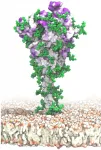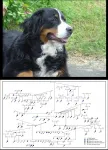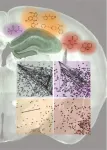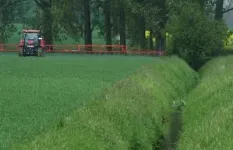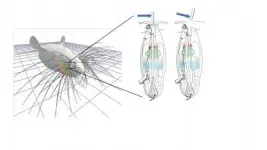First-of-its-kind mechanical model simulates bending of mammalian whiskers
Model provides new insights into how whisker bending translates to sensory touch signals
2021-04-01
(Press-News.org) Researchers have developed a new mechanical model that simulates how whiskers bend within a follicle in response to an external force, paving the way toward better understanding of how whiskers contribute to mammals' sense of touch. Yifu Luo and Mitra Hartmann of Northwestern University and colleagues present these findings in the open-access journal PLOS Computational Biology.
With the exception of some primates, most mammals use whiskers to explore their environment through the sense of touch. Whiskers have no sensors along their length, but when an external force bends a whisker, that deformation extends into the follicle at the base of the whisker, where the whisker pushes or pulls on sensor cells, triggering touch signals in the nervous system.
Few previous studies have examined how whiskers deform within follicles in order to impinge on the sensor cells--mechanoreceptors--inside. To better understand this process, Luo and colleagues drew on data from experimental studies of whisker follicles to create the first mechanical model capable of simulating whisker deformation within follicles.
The simulations suggest that whisker deformation within follicles most likely occurs in an "S" shape, although future experimental data may show that the deformation is "C" shaped. The researchers demonstrate that these shape estimates can be used to predict how whiskers push and pull on different kinds of mechanoreceptors located in different parts of the follicle, influencing touch signals sent to the brain.
The new model applies to both passive touch and active "whisking," when an animal uses muscles to move its whiskers. The simulations suggest that, during active whisking, the tactile sensitivity of the whisker system is enhanced by increased blood pressure in the follicle and by increased stiffness of follicular muscle and tissue structures.
"It is exciting to use simulations, constrained by anatomical observations, to gain insights into biological processes that cannot be directly measured experimentally," Hartmann says. "The work also underscores just how important mechanics are to understanding the sensory signals that the brain has evolved to process."
Future research will be needed to refine the model, both computationally and by incorporating new experimental data.
INFORMATION:
Peer-reviewed; Simulation / modelling
In your coverage please use this URL to provide access to the freely available article in PLOS Computational Biology:
https://journals.plos.org/ploscompbiol/article?id=10.1371/journal.pcbi.1007887
Citation: Luo Y, Bresee CS, Rudnicki JW, Hartmann MJZ (2021) Constraints on the deformation of the vibrissa within the follicle. PLoS Comput Biol 17(4): e1007887. https://doi.org/10.1371/journal.pcbi.1007887
Funding: This work was supported by NIH award R01-NS093585 to MJZH. The funders had no role in study design, data collection and analysis, decision to publish, or preparation of the manuscript.
Competing Interests: The authors have declared that no competing interests exist.
[Attachments] See images for this press release:
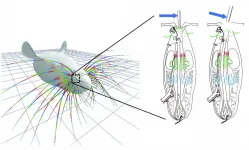
ELSE PRESS RELEASES FROM THIS DATE:
2021-04-01
A new, detailed model of the surface of the SARS-CoV-2 spike protein reveals previously unknown vulnerabilities that could inform development of vaccines. Mateusz Sikora of the Max Planck Institute of Biophysics in Frankfurt, Germany, and colleagues present these findings in the open-access journal PLOS Computational Biology.
SARS-CoV-2 is the virus responsible for the COVID-19 pandemic. A key feature of SARS-CoV-2 is its spike protein, which extends from its surface and enables it to target and infect human cells. Extensive research has resulted in detailed static models of the spike protein, but these models do not capture the flexibility of the spike protein itself nor the movements of protective glycans--chains ...
2021-04-01
Six genetic variants add up to determine the risk of several blood cancers in pre-disposed dog breeds, according to a study by Benoît Hédan at the University of Rennes and colleagues, publishing April 8th in the open-access journal PLOS Genetics. The results confirm a known tumour-suppressor gene as a risk factor for histiocytic sarcoma -- a rare and aggressive blood cancer that affects both dogs and humans -- as well as identifying four new genetic loci associated with the disease.
The researchers sequenced genomic DNA extracted from blood samples from Bernese mountain dogs, Rottweilers, flat-coated retrievers, and golden retrievers, including ...
2021-04-01
Memory loss is common after general anesthesia, particularly for events occurring immediately before surgery--a phenomenon called retrograde amnesia. But a new study publishing on April 1st 2021 in the open access journal PLOS Biology, led by Simon Wiegert at the University Medical Center Hamburg-Eppendorf in Germany, shows that changes in the hippocampus--the part of the brain used to make new memories--differ depending on which general anesthetic is used. Consequently, their effects on memory formation also differ.
Understanding how different anesthetics affect the brain, particularly the hippocampus, is therefore important for both clinicians with human patients and experimental scientists who work with animals. Wiegert and his team recorded brain activity from the hippocampus ...
2021-04-01
Achuta Kadambi, an assistant professor at the UCLA Samueli School of Engineering, published a column in the journal Science about how medical devices can be fundamentally biased -- not just in dataset representation as has been widely reported, but from a deeper root: the laws of physics.
Kadambi described how the inherent physics behind medical devices could vary across race and gender. He cited several examples of potential physics-based bias. For example, recent research has shown that a pulse oximeter -- a medical device typically placed on a fingertip that uses infrared and light beams to measure oxygen saturation of the blood and the pulse rate -- is more likely to miss low levels in people with darker skin.
What motivated Kadambi to write this piece stemmed from ...
2021-04-01
A group of scientists from the University of Koblenz-Landau, Germany, has shown that for plants and insects the applied pesticide toxicity in agriculture has substantially increased between 2004 and 2016. In a paper published in the current issue of Science, the authors show that this pattern is even relevant in genetically modified (GM) crops that were originally designed to reduce pesticide impacts on the environment.
"We have taken a large body of pesticide use data from the US and have expressed changes of amounts applied in agriculture over time as changes in total applied pesticide toxicity," says lead author Ralf Schulz, professor for environmental sciences in Landau. "This provides a new view on the potential ...
2021-04-01
We know your cat's whiskers are handsome -- but you can't even see the cool part.
The base of the whisker, which is responsible for sending touch signals to the brain, is hidden inside the follicle, a deep pocket that embeds the whisker within the skin. Because this section of the whisker is obscured, understanding precisely how whiskers communicate touch to the brain has been a longstanding mystery.
In a new study, an interdisciplinary team of researchers at Northwestern University has developed the first mechanical simulation of the whisker inside the follicle. By combining their new model with new anatomical observations, the researchers discovered that when whiskers touch an object, they ...
2021-04-01
For the first time, researchers have discovered a way to obtain polarity and photovoltaic behavior from certain nonphotovoltaic, atomically flat (2D) materials. The key lies in the special way in which the materials are arranged. The resulting effect is different from, and potentially superior to, the photovoltaic effect commonly found in solar cells.
Solar power is considered a key technology in the move away from fossil fuels. Researchers continually innovate more efficient means to generate solar energy. And many of these innovations come from the world of materials research. ...
2021-04-01
Despite a reduction in the total amounts of pesticides used, the toxicity of commonly used pesticides to nontarget species, partially aquatic invertebrates and pollinators, has increased considerably in recent decades, according to a new study analyzing 25 years of pesticide use. This has been driven by the widespread use of highly toxic pyrethroid and neonicotinoid pesticides. The findings challenge claims suggesting that the overall environmental impacts of pesticide use have declined. The impacts of applied pesticides on humans and the environment are often based on comparisons of use rates (e.g., kilograms per hectare) or the total amounts used (e.g., kilograms per year). However, from an environmental perspective, these weight-based ...
2021-04-01
Technology can be biased, and its design can disadvantage certain demographic groups. While efforts to address bias and promote fairness in technologies are rapidly growing in a variety of technical disciplines, Achuta Kadambi argues that similar growth is not occurring fast enough for medical engineering. "Although computer science companies terminate lucrative but biased facial recognition systems, biased medical devices continue to be sold as commercial products," writes Kadambi in a Perspective. Bias in medical devices results in undesirable performance variation across demographic groups and can greatly influence health inequality. For example, optical biosensors that use light to monitor vital signs like blood oxygenation ...
2021-04-01
In an analysis of thousands of fossil pollen and leaves spanning the Cretaceous-Paleogene (K/Pg) boundary, researchers found that the cataclysmic asteroid impact that resulted in the destruction of nearly 75% of all terrestrial life on Earth drastically restructured tropical forests, setting the stage for the evolution of what has become one of the planet's most diverse ecosystems - the neotropical rainforest. While the end-Cretaceous impact nearly 66 million years ago was catastrophic for terrestrial ecosystems worldwide, its long-term effects on tropical forests have remained a mystery. This is largely due to the lack of palaeobotanical exploration in the region, which has only just begun to provide ...
LAST 30 PRESS RELEASES:
[Press-News.org] First-of-its-kind mechanical model simulates bending of mammalian whiskers
Model provides new insights into how whisker bending translates to sensory touch signals

